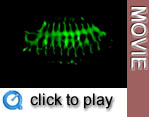Development of the trachea
 The
tracheal system develops from 10 segmental specializations of the lateral
ectoderm, the so-called tracheal placodes, which are first apparent in stage
10. Cells of the tracheal placodes divide and invaginate to form the tracheal
pits of about 80 cells. From this point on, subsequent processes of tracheal
morphogenesis are based on cell migration and cell shape changes, without
any further division.
The
tracheal system develops from 10 segmental specializations of the lateral
ectoderm, the so-called tracheal placodes, which are first apparent in stage
10. Cells of the tracheal placodes divide and invaginate to form the tracheal
pits of about 80 cells. From this point on, subsequent processes of tracheal
morphogenesis are based on cell migration and cell shape changes, without
any further division.In every hemisegment, the tracheal cells follow highly stereotypic migration pathways. Five primary branches form when cells of the tracheal sacks migrate into different directions. Later in development, secondary branches, which are formed by single cells, sprout out from the primary branches.
The tracheal branches of each hemisegment fuse to branches of the neighboring segment and to those of the contra lateral side, forming a widely ramified, interconnected mesh. The opening of each tracheal pit to the outside disappears in stage 12, during germ band shortening, when the pits close over. At the end of development, the tracheal system is open to the outside only at the posterior spiracles, which develop from special cells in the abdominal segment a8. These structures fuse to the first and eighth tracheal pit, respectively.
 The
Drosophila homologue of the FGF receptor breathless (btl) and its
ligand branchless (bnl) play a central role in the formation and migration
of the primary branches in tracheal development. bnl is expressed
in defined ectodermal and mesodermal cells, acting as a chemo attractant
for tracheal cells, which express btl.
The
Drosophila homologue of the FGF receptor breathless (btl) and its
ligand branchless (bnl) play a central role in the formation and migration
of the primary branches in tracheal development. bnl is expressed
in defined ectodermal and mesodermal cells, acting as a chemo attractant
for tracheal cells, which express btl. In addition, further branch-specific determinants are required in the tracheal cells to ensure correct migration behavior. knirps and knirps related specify the cells of the presumptive dorsal and ventral branches. This is crucial for their correct response to the bnl signal. knirps and knirps related are induced in tracheal cells in response to decapentaplegic signaling. Similarly, spalt, which is induced by wingless signaling, is required in the tracheal cells that will form the dorsal trunc. A single hunchback-expressing mesodermal cell is required to connect the anterior dorsal trunc of one segment to the posterior dorsal trunc of its neighboring tracheal metamere.
Media list
Genes discussed
|
Gene
|
Gene product
- Domains
|
Function
|
Links
|
|
branchless (bnl)
|
fibroblast growth factor homolog
|
ligand for Breathless and Heartless - Drosophila's only
known FGF
|
|
|
breathless (btl)
|
transmembrane receptor, FGF-receptor homolog
|
guides migraton of trachea and CNS midline cells
|
|
|
decapentaplegic (dpp)
|
ligand - TGF-ß homolog
|
Dpp establishes the dorsal / ventral pattern and defines
compartment boundaries
|
|
|
hunchback
(hb)
|
transcription factor - zinc finger |
gap gene, later required for proper temporal generation
of NB sublineages
|
|
|
knirps (kni)
|
transcription factor - steroid receptor - zinc finger
|
gap gene, later organizes the development of the second
wing vein
|
|
|
knirps related (also named knirps-like
(knrl))
|
ligand-dependent nuclear receptor - transcription
factor
|
regulation of mitosis
|
|
|
spalt (salm)
|
transcription factor - zinc finger - PRDII-BF1 homolog
|
a target of Dpp signaling - Spalt and Spalt-related
regulate vein-specific expression of knirps and the iroquois complex
|
|
|
wingless (wg)
|
ligand - wnt family
|
segment polarity gene, intercellular signaling protein
|